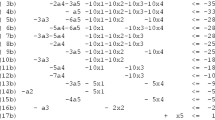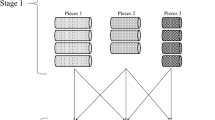Abstract
The dynamic economic lot sizing model, which lies at the core of numerous production planning applications, is one of the most highly studied models in all of operations research. And yet, capacitated multi-item versions of this problem remain computationally elusive. We study the polyhedral structure of an integer programming formulation of a single-item capacitated version of this problem, and use these results to develop solution methods for multi-item applications. In particular, we introduce a set of valid inequalities for the problem and show that they define facets of the underlying integer programming polyhedron. Computational results on several single and multiple product examples show that these inequalities can be used quite effectively to develop an efficient cutting plane/branch and bound procedure. Moreover, our results show that in many instances adding certain of these inequalities a priori to the problem formulation, and avoiding the generation of cutting planes, can be equally effective.
Similar content being viewed by others
References
S. Axsäter, “Worst case performance for lot sizing heuristics,”European Journal of Operational Research 9 (1982) 339–343.
S. Axsäter, “Performance bounds for lot sizing heuristics,”Management Science 31 (1985) 634–640.
K.R. Baker, P. Dixon, M.J. Magazine and E.A. Silver, “An algorithm for the dynamic lot-size problem with time-varying production capacity constraints,”Management Science 24 (1978) 1710–1720.
A. Balakrishnan, “LP extreme points and cuts for the fixed charge network design problem,”Mathematical Programming 39 (1987) 263–284.
A. Balakrishnan and T.L. Magnanti, “Set packing-based cuts for the fixed charge network design problem,”Bulletin 20, ORSA/TIMS, Atlanta (1985) 51.
E. Balas, “On the facial structure of scheduling polyhedra, “Management Science Research Report No. 496(R), Graduate School of Industrial Administration, Carnegie-Mellon University (1984).
E. Balas and M.W. Padberg, “Set partitioning: A survey,”SIAM Review 18 (1976) 710–760.
E. Balas and E. Zemel, “Critical cutsets of graphs and canonical facets of set-packing polytopes,”Mathematics of Operations Research 2 (1977) 15–19.
M.L. Balinski, “Fixed-cost transportation problems,”Naval Research Logistics Quarterly 8 (1961) 41–54.
I. Barany, T.J. Van Roy and L.A. Wolsey, “Uncapacitated lot-sizing: The convex hull of solutions,”Mathematical Programming Study 22 (1984a) 32–43.
I. Barany, T.J. Van Roy and L.A. Wolsey, “Strong formulations for multi-item capacitated lot sizing,”Management Science 30 (1984b) 1255–1261.
G.R. Bitran, T.L. Magnanti and H.H. Yanasse, “Approximation methods for the uncapacitated dynamic lot size problem,”Management Science 30 (1984) 1121–1140.
G.R. Bitran and H. Matsuo, “Approximation formulations for the single-product capacitated lot size problem,”Operations Research 34 (1986a) 63–74.
G.R. Bitran and H. Matsuo, “The multi-item capacitated lot size problem: Error bounds of Manne's formulations,”Management Science 32 (1986b) 350–359.
G.R. Bitran and H.H. Yanasse, “Computational complexity of the capacitated lot size problem,”Management Science 28 (1982) 1174–1186.
D.C. Cho, E.L. Johnson, M.W. Padberg and M.R. Rao, “On the uncapacitated plant location problem I: Valid inequalities and facets,”Mathematics of Operations Research 8 (1983a) 579–589.
D.C. Cho, M.W. Padberg and M.R. Rao, “On the uncapacitated plant location problem II: Facets and lifting theorems,”Mathematics of Operations Research 8 (1983b) 590–612.
V. Chvátal, “Edmonds polytopes and a hierarchy of combinatorial problems,”Discrete Mathematics 4 (1973) 305–337.
V. Chvátal, “On certain polytopes associated with graphs,”Journal of Combinatorial Theory B 18 (1975) 138–154.
L. Cooper and C. Drebes, “An approximate solution method for the fixed charge problem,”Naval Research Logistics Quarterly 14 (1967) 101–113.
G. Cornuejols and J-M. Thizy, “Some facets of the simple plant location polytope,”Mathematical Programming 23 (1982) 50–74.
H. Crowder, E.L. Johnson and M.W. Padberg, “Solving large-scale zero–one linear programming problems,”Operations Research 31 (1983) 803–834.
H. Crowder and M.W. Padberg, “Solving large-scale symmetric travelling salesman problems to optimality,”Management Science 26 (1980) 495–509.
D.R. Danzler, “An approximate algorithm for the fixed charge problem,”Naval Research Logistics Quarterly 16 (1969) 411–416.
P.S. Dixon and E.A. Silver, “A heuristic solution procedure for the multi-item, single level, limited capacity, log sizing problem,”Journal of Operations Management 2 (1981) 23–29.
A. Dogramaci, J.E. Panayiotopoulos and N.R. Adam, “The dynamic lot sizing problem for multiple items under limited capacity,”AIIE Transactions 13 (1981) 294–303.
B.P. Dzielinski, C.T. Baker and A.S. Manne, “Simulation tests of lot size programming,”Management Science 9 (1963) 229–258.
B.P. Dzielinski and R.E. Gomory, “Optimal programming of lot sizes, inventory and labor allocations,”Management Science 11 (1965) 874–890.
J. Edmonds, “Maximum matching and a polyhedron with 0, 1-vertices,”Journal of Research of the National Bureau of Standards. Section B 69 (1965) 125–130.
G.D. Eppen, F.J. Gould and B.P. Pashigian, “Extensions of the planning horizon theorem in the dynamic lot size model,”Management Science 15 (1969) 268–277.
G.D. Eppen and R.K. Martin, “Solving multi-item capacitated lot sizing problems using variable redefinition,”Operations Research 35 (1987) 832–848.
M. Florian and M. Klein, “Deterministic production planning with concave costs and capacity constraints,”Management Science 18 (1971) 12–20.
M. Florian, J.K. Lenstra and A.H.G. Rinnooy Kan, “Deterministic production planning: algorithms and complexity,”Management Science 26 (1980) 669–679.
M.R. Garey and D.S. Johnson,Computers and Intractability: A Guide to the Theory of NP-Completeness (Freeman, San Francisco, CA, 1979).
S.C. Graves, “Using Lagrangean techniques to solve hierarchical production planning problems,”Management Science 28 (1982) 260–275.
P. Gray, “Exact solution of the fixed-charge transportation problem,”Operations Research 19 (1971) 1529–1538.
M. Grötschel, “Polyhedral combinatorics,” in: M. O'hEigeartaigh, J.K. Lenstra and A.H.G. Rinnooy Kan, eds.,Combinatorial Optimization: Annotated Bibliographies (Wiley Interscience, New York, 1985).
M. Grötschel and O. Holland, “Solving matching problems with linear programming,” Preprint No. 37, Mathematisches Institut, Universitat Augsburg (Augsburg, FRG, 1984).
M. Grötschel, M. Jünger and G. Reinelt, “A cutting plane algorithm for the linear ordering problem,”Operations Research 32 (1984) 1195–1220.
M. Grötschel, M. Jünger and G. Reinelt, “Facets for the linear ordering problem,”Mathematical Programming 33 (1985) 43–60.
M. Grötschel, L. Lovasz and A. Schrijver, “The consequences of the ellipsoid method for combinatorial optimization,”Combinatorica 1 (1981) 169–198.
M. Grötschel and M.W. Padberg, “On the symmetric travelling salesman problem I: Inequalities,”Mathematical Programming 16 (1979a) 265–280.
M. Grötschel and M.W. Padberg, “On the symmetric travelling salesman problem II: Lifting theorems and facets, “Mathematical Programming 16 (1979b) 281–302.
A.C. Hax and C. Candea,Production and Inventory Management (Prentice-Hall, Englewood Cliffs, NJ, 1984).
K. Hoffman and M.W. Padberg, “LP-based combinatorial problem solving,”Annals of Operations Research 4 (1985) 145–194.
R. Jagannathan and M.R. Rao, “A class of deterministic production planning problems,”Management Science 19 (1973) 1295–1300.
E.L. Johnson, M.M. Kostreva and H.H. Suhl, “Solving 0–1 integer programming problems arising from large scale planning models,”Operations Research 33 (1985) 803–820.
A.P. Jones and R.M. Soland, “A branch-and-bound algorithm for multi-level fixed-charge problems,”Management Science 16 (1969) 67–76.
B.A. Kalymon, “A decomposition algorithm for arborescence inventory systems,”Operations Research 20 (1972) 860–874.
R.M. Karp and C.H. Papadimitriou, “On linear characterization of combinatorial optimization,”SIAM Journal of Computing 11 (1982) 620–632.
P.R. Kleindorfer and E.F.P. Newson, “A lower bounding structure for lot size scheduling problems,”Operations Research 23 (1975) 299–311.
K.O. Kortanek, D. Sodaro and A.L. Soyster, “Multi-product production scheduling via extreme point properties of linear programming,”Naval Research Logistics Quarterly 15 (1968) 287–300.
M. Lambrecht and J. Vander Eecken, “A capacity constrained single-facility dynamic lot-size model,”European Journal of Operational Research 2 (1978) 132–136.
M. Lambrecht and H. Vanderveken, “Heuristic procedure for the single operation multi-item loading problem,”AIIE Transactions 11 (1979) 319–326.
L.S. Lasdon and R.C. Terjung, “An efficient algorithm for multi-item scheduling,”Operations Research 19 (1971) 946–969.
J.M.Y. Leung and T.L. Magnanti, “Valid inequalities and facets of the capacitated plant location problem,”Mathematical Programming 44 (1989) 271–292.
S.F. Love “Bounded production and inventory models with piecewise concave costs,”Management Science 20 (1973) 313–318.
J. Maes and L.N. Van Wassenhove, “Multi item single level capacitated dynamic lotsizing heuristics: A computational comparison (Part I: Static case),”IIE Transactions 18 (1986a) 114–123.
J. Maes and L.N. Van Wassenhove, “Multi item single level capacitated dynamic lot sizing heuristics: A computational comparison (Part II: Rolling horizon),”IIE Transactions 18 (1986b) 124–129.
A.S. Manne, “Programming of economic lot sizes,”Management Science 4 (1958) 115–135.
R.K. Martin and L. Schrage, “Constraint Aggregation and Coefficient Reduction Cuts for Mixed-0/1 linear Programming,” Graduate School of Business, University of Chicago (Chicago, IL, 1986).
K.G. Murty “Solving the fixed charge problem by ranking the extreme points,”Operations Research 16 (1968) 268–279.
G.L. Nemhauser and L.E. Trotter, “Properties of vertex packing and independence system polyhedra,”Mathematical Programming 6 (1974) 48–61.
G.L. Nemhauser and L.A. Wolsey, “A recursive procedure for generating all mixed integer cuts,”Bulletin 20, ORSA/TIMS, Atlanta (1985) 137.
G.L. Nemhauser and L.A. Wolsey,Integer and Combinatorial Optimization (Wiley/Interscience, New York, 1988).
E.F.P. Newson, “Multi-item lot size scheduling by heuristic. Part I: With fixed resources,”Management Science 21 (1975) 1186–1193.
J. Orlicky,Material Requirements Planning: The New Way of Life in Production and Inventory Management (McGraw-Hill, New York, 1974).
M.W. Padberg, “On the facial structure of set packing polyhedra,”Mathematical Programming 5 (1973) 199–215.
M.W. Padberg, “Covering, packing and knapsack problems,”Annals of Discrete Mathematics 4 (1979) 265–287.
M.W. Padberg and S. Hong, “On the symmetric travelling salesman problem: A computational study,”Mathematical Programming Study 12 (1980) 78–107.
M.W. Padberg and M.R. Rao, “Odd minimum cut-sets andb-matchings,”Mathematics of Operations Research 7 (1982) 67–80.
M.W. Padberg and G. Rinaldi, “Optimization of a 532-city symmetric traveling salesman problem by branch and cut,”Operations Research Letters 6 (1987) 1–8.
M.W. Padberg, T.J. Van Roy and L.A. Wolsey, “Valid linear inequalities for fixed charge problems,”Operations Research 33 (1985) 842–861.
R. Peterson and E.A. Silver,Decision Systems for Inventory Management and Production Planning (Wiley, New York, 1979).
Y. Pochet, “Valid inequalities and separation for capacitated economic lot sizing,”Operations Research Letters 7 (1988) 109–116.
Y. Pochet and L.A. Wolsey, “Lot-size models with backlogging: Strong formulations and cutting planes,”Mathematical Programming 40 (1988) 317–335.
D. I. Steinberg, “The fixed charge problem,”Naval Research Logistics Quarterly 17 (1970) 217–235.
J.-M. Thizy and L.N. Van Wassenhove, “Decomposition algorithms for the multi-product lot-sizing problem with capacity constraints,” Report 82-15, Department of Industrial Engineering, Katholieke Universiteit Leuven (Leuvon, Belgium, 1986).
L.E. Trotter, “A class of facet producing graphs for vertex packing polytopes,”Discrete Mathematics 12 (1975) 373–388.
R. Vachani, “Analysis of heuristics for the uncapacitated lot size problem,” Unpublished manuscript, Sloan School of Management, MIT (Cambridge, MA, 1984).
A.F. Veinott “Minimum concave-cost solution of Leontief substitution models of multi-facility inventory systems,”Operations Research 17 (1968) 262–291.
H.M. Wagner and T.M. Whitin, “Dynamic version of the economic lot size model,”Management Science 5 (1958) 89–96.
W.E. Walker, “A heuristic adjacent extreme point algorithm for the fixed charge problem,”Management Science 22 (1976) 587–596.
E. Zabel, “Some generalizations of an inventory planning horizon theorem,”Management Science 10 (1964) 465–471.
W.I. Zangwill, “A deterministic multi-period production scheduling model with backlogging,”Management Science 13 (1966) 105–119.
W.I. Zangwill, “A backlogging model and multi-echelon model of a dynamic economic lot size production system—A network approach,”Management Science 15 (1969) 506–527.
Author information
Authors and Affiliations
Additional information
Supported by Grant #ECS-8316224 from the Systems Theory and Operations Research Program of the National Science Foundation.
Rights and permissions
About this article
Cite this article
Leung, J.M.Y., Magnanti, T.L. & Vachani, R. Facets and algorithms for capacitated lot sizing. Mathematical Programming 45, 331–359 (1989). https://doi.org/10.1007/BF01589110
Received:
Revised:
Issue Date:
DOI: https://doi.org/10.1007/BF01589110




